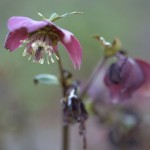Hi there, welcome again to the Nuacht Chlairs gardening section. This month is quite a busy one for the gardener, with many worthy tasks to be undertaken. However, don’t worry as the many and varied rain showers we receive will cause you to seek shelter and relax between tasks. During one of these breaks, I suggest you take time out to consider this issues VIP (very important plant).
Aubrieta deltoidea
Within your rockery, consider planting Aubrieta deltoidea, which is commonly known as rock cress.
This frost hardy perennial which originated in South-eastern Europe, grows to a height of 15cms (5 inches), with a spread of approx 0.6 mtr (2ft). A vital colour contributor to the garden this time of year, Aubrieta’s four petalled flowers are available in red, pink, purple and blue depending on the variety planted. The reliable flowers cover the grey-green ladle shaped leaves from March until June.
Employ this long flowering plant to sprawl rapidly at the front of beds and borders or use it to tumble down your rockery. Trailing Aubrieta tumbling within a rock garden alongside spring bulbs such as daffodils, tulips and grape hyacinths is another great planting combination. Other rockery perennials that sit well with Aubrieta include Alyssum montanum, Arabis causcasica, Phlox subulata, Saponaria ocymoides and Saxifraga.
Give Aubrieta deltoidea a position in full to partial sun with well-drained soil; it will produce superior blooms in a soil that contains traces of lime. Regular trimming after flowering will help prevent lanky growth and Aubrieta’s habit of swamping nearby plantings. Rejuvenate overgrown specimens of Aubrieta deltoidea by division in autumn.
Good points
· Grows in most fertile soil types, with heavier flowering on limestone-based soils.
· A tough and low maintenance perennial.
· Can be transplanted, good survival rates.
· Division in autumn will allow you to increase your stock.
Poor points
· Has a tendency to swamp or engulf surrounding plantings. Carry out a yearly trimming after flowering.
Main pests and diseases
· Powdery mildew, this is encouraged when soils are dry but the air is damp.
· Downey mildew, due to moist growing conditions.
· Flea beetles may create small round holes on the leaves. This is not fatal on established plantings.
· Aphids, this pest is common to many shrubs and perennials.
Garden tasks for April
Hoe, dig out or apply a herbicide to weeds as they appear.
Keep a watchful eye out for slugs; they are active this time of year. Apply slug pellets or a dressing of sharp gravel around susceptible plants.
Remove spent flower heads from daffodils and allow the remaining foliage to die down naturally.
Plant bulbs for summer colour such as dahlias and gladioli.
Apply a slow release fertiliser to shrubs, trees and perennials.
Spray roses that are in leaf against blackspot and powdery mildew.
Your roses will also benefit from a mulch or layer of well-rotted compost applied to their base.
Fruit bushes / trees will also benefit from a similar application.
In the veg garden, sow seeds of lettuce, peas, beetroot, radishes etc.
So until next month, happy gardening and remember that a weed is just a plant in the wrong place.
James Kilkelly runs a garden and landscape design service just outside the village of Monivea.
If you would like to view sample design drawings or simply pick up some design tips then visit his website www.gardenplansireland.com
Alternatively, contact James by phone on 087-206 7846.


